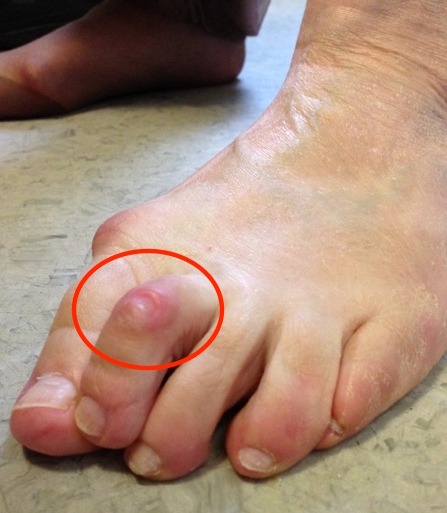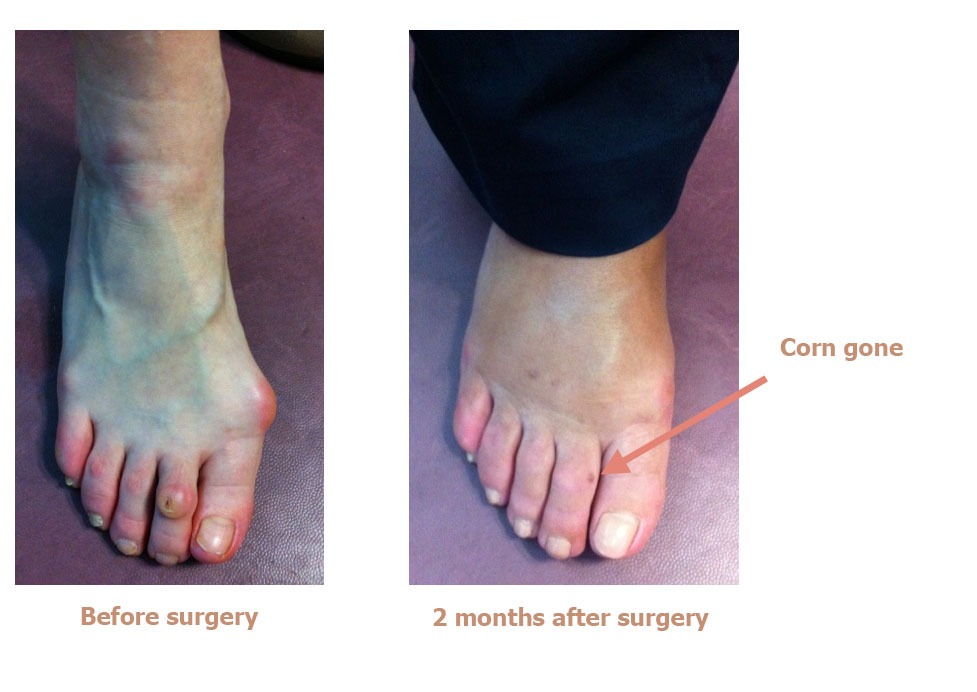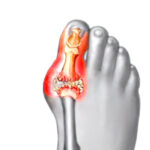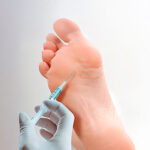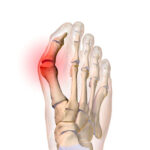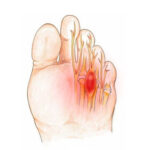Home » Pathologies » Forefoot surgery » Hammer Toe
Hammer Toe
Hammer toe is a deformity where the toe is bent and cannot be straightened. Often caused by hallux valgus (a bunion on the big toe), the deformity causes the toe to rub constantly against the inside of shoes. This rubbing leads to severe pain and corns that keep coming back, despite pedicure treatments. Treatment is surgery and involves simultaneous correction of the hallux valgus.
Dr Lévy treats Hammer Toe using a percutaneous minimally-invasive technique.
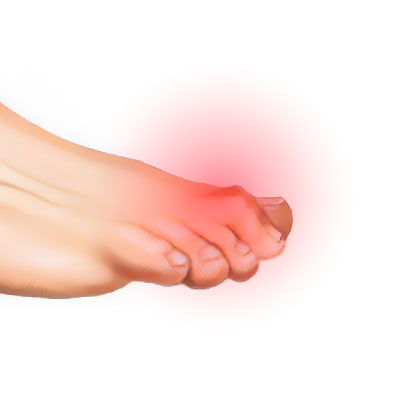
Description & progression
Hammer toe is a common foot problem. It refers to a deformity of one or more toes where they are bent and cannot be straightened, causing them to rub against the inside of shoes. The top of the hammer-shaped toe rubs against the top of the shoe, causing burning pain and corns on the top of the toe.
 The deformity can also place excessive pressure on the ball of the toe. It mainly affects women in their fifties. The problem is often related to hallux valgus (bunions), but can also occur with a hollow foot, rheumatoid arthritis or other foot problems. Without surgery to remove the deformity, treating the corns with pedicures is pointless. In fact, the corns will come back very quickly because the toe will still rub against the shoes.
The deformity can also place excessive pressure on the ball of the toe. It mainly affects women in their fifties. The problem is often related to hallux valgus (bunions), but can also occur with a hollow foot, rheumatoid arthritis or other foot problems. Without surgery to remove the deformity, treating the corns with pedicures is pointless. In fact, the corns will come back very quickly because the toe will still rub against the shoes.
In the early stages of the condition, the deformed toe is supple and painless. Then it becomes stiff and cannot be straightened. Eventually, if left untreated, it can lead to dislocation of the metatarsophalangeal joint and crippling pain in the sole of the foot.
The corn can get infected and lead to arthritis (infection) of the toe.
Treatment
The only treatment is surgery. However, the surgery should not be limited to just the hammer deformity. It is important to address the underlying cause of the deformity. This means any hallux valgus (even if asymptomatic) should also be treated at the same time, otherwise the hammer deformity may recur or even affect other toes too.
Preparing for surgery
SURGICAL CONSULTATION:
The aim of the preoperative consultation with Dr Lévy is to establish a diagnosis. He will examine the structure of your foot to see whether it is flat or hollow. The examination will check for increased forefoot pressure with calluses on the sole of the foot beneath the metatarsal head. He will also check for the cause of the deformity (usually hallux valgus, or a bunion).
X-rays will be used to help plan the surgery. Dr Lévy will explain what will happen during and after the surgery, as well as any potential complications.
ANAESTHETIC CONSULTATION:
Once the indications have been confirmed, one of Dr Lévy’s assistants will give you an appointment with the anaesthetist who will look after you during the surgery. The anaesthetist will examine you and prescribe any additional tests that may be needed before the surgery. He or she will also explain how the anaesthesia works and the best method for you.
SMOKING :
It is essential to stop smoking one month before and after the surgery. This is because a mass influx of nicotine reduces blood flow to the foot and makes it harder for the bone to heal, causing prolonged pain. You may use extended-release nicotine patches to help with the withdrawal symptoms.
Hospital stay & procedure
The surgery is usually carried out as an outpatient procedure (day hospital)
ANAESTHESIA :
The procedure will be performed under local anaesthesia. The anaesthetist will first give you a local anaesthetic into the toe so you won’t feel any pain or discomfort during the surgery. The surgeon will then top-up the anaesthesia once the area is numbed. This top-up is used to prolong the effects of the anaesthesia for 10–12 hours. You will therefore not be in any pain when you return home. When you are discharged from the clinic, you will be given a prescription for pain relief.
PERCUTANEOUS SURGERY :
Dr Lévy will perform the operation using micro-incisions for inserting instruments just 2mm in diameter. This means the scars will be barely visible to the naked eye. If there is still flexibility in the hammer toe, the surgeon will cut the extensor tendon and release the metatarsophalangeal joint (a procedure known as arthrolysis). If the toe can no longer be straightened, he will also remove some bone from the end of the distal phalanx (top of the toe). It is this excess length that is causing the deformity. By removing a few millimetres of bone, the surgeon is creating space for the toe to straighten out again. No fixation material is used (e.g. screws, staples).
Throughout the operation, Dr Lévy will take x-rays to check what is happening and make sure the osteotomy is as accurate as possible.
Once finished, he will apply a compression dressing that will act as a splint for 8–10 days, during which you should not remove or loosen the bandage or get it wet.
You will then spend a few minutes in the recovery room so your vital signs can be monitored, before returning to your room and waiting to be discharged.
Dr Lévy will prescribe any medication needed to alleviate any pain after the surgery. When you are discharged, you will be given a copy of your medical file explaining that you must bring back the dressings to your next check-up, along with any other instructions and the date and time of your next appointment when you will have another x-ray.
After being discharged, you will be able to walk with orthopaedic shoes that Dr Lévy will have prescribed for you during the preoperative consultation.
After the surgery
Dr Lévy will give you an appointment for a check-up in 8–10 days’ time. During this time, you must wear the orthopaedic shoes which are designed to relieve pressure on the forefoot.
POSTOPERATIVE CHECK-UPS :
8–10 DAY CHECK-UP :
Dr Lévy will remove the dressing and affix a splint to hold and keep the toe straight. This splint will make sure the bone heals in the correct position. You will must continue wearing the orthopaedic shoes for one month.
1-MONTH CHECK-UP :
The dressing and splint will be removed. You will return the orthopaedic shoes and can start wearing loose-fitting footwear (e.g. trainers, plimsolls). The swelling may take 2–3 months to go down. You will also be given some exercises to do at home to help recover the full range of motion in your toes.
3-MONTH CHECK-UP :
This appointment is to check how your toes are healing. However, each case is different and you may be given advice on how to improve your condition and speed up your recovery.
You may also be given further appointments, if the surgeon thinks it is necessary.
REHABILITATION :
The benefit of percutaneous surgery is less stiffness after the procedure. In most cases there is no need for rehabilitation therapy. At your first check-up appointment, Dr Lévy will give you some exercises to do at home. These exercises are designed to restore the range of motion in the joints, massage the scars to prevent any deep-seated adhesions, and get you walking again normally.
In some cases, he may want to prescribe you some sessions with a physiotherapist.
Recovery period & Return to work
The length of time you need to take off work will depend on your job and how you travel to get there. The type of procedure means there will be swelling for about two months after the surgery.
You should not drive for 10 days (unless you have an automatic car and operate the pedals using the other foot). Likewise, you should not expect to be able to walk for long distances for at least two weeks.
For example, if you work in an office located 5 minutes from your house, you can expect to return to work in 10 days, or possibly even one week after the surgery. On the other hand, if you have a physically active job with a 2-hour daily commute, you may need to take a whole month off. These are just two examples, and your situation may lie anywhere in between.
If the surgery treated a hallux valgus (bunion) as well as a hammer toe, you will need to take longer off work, as advised for hallux valgus surgery.
Potential complications
A wide range of complications can occur with surgery. Fortunately, they are very rare and the various appointments before and after the surgery are designed to avoid them or detect them early if they do appear.
As well as the risks common to all types of surgery and the risks of the anaesthesia, there are some specific risks associated with this procedure.
The following complications may occur with percutaneous surgery of the foot:
SURGICAL WOUND INFECTION :
Despite all the precautions taken by the operating team, bacteria may still enter the wound either during the surgery or afterwards, before it is fully healed. Signs and symptoms of an infection are compromised healing with severe pain, more redness around the wound than normal, a purulent discharge and a persistent fever.
You must tell the surgeon if you see any of these signs and seek emergency treatment.
DELAYED HEALING :
Sometimes, the bones take longer than three months to heal. This is often the case with smokers who were unable to quit before, during and/or after the surgery due to the decreased blood flow to the toes. In these cases, Dr Lévy will give you advice on how to reduce pressure on the bones and help them heal faster.
COMPLEX REGIONAL PAIN SYNDROME :
Complex Regional Pain Syndrome, also known as algodystrophy, is a condition involving pain and other symptoms usually in a limb following trauma or surgery, even if only minor. The syndrome may have a neurological cause such as damage to the peripheral nervous system, affecting either the small fibres which protect from pain or heat stimuli, and/or the large fibres which detect tactile stimuli. It causes pain and severe stiffness that can last for up to 18 months. Patients always recover fully. Dr Lévy will diagnose the condition using scintigraphy (a scan) and will support you throughout, in order to treat the painful and unpleasant symptoms.
PHLEBITIS/PULMONARY EMBOLISM :
Despite being able to walk again immediately, a clot may form in one of the veins of your leg (phlebitis) and require an effective dose of anticoagulant treatment for 3–6 months. This complication is rare with percutaneous surgery because the patient can walk again the same day.
This list does not cover all the possible risks.
Ask Dr Lévy if you want more information, especially if you have any questions about your particular situation and the advantages, disadvantages and risk/benefit ratio of each procedure.

